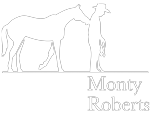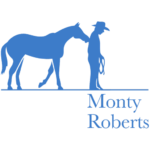Project Description
Monty Roberts NEW Introductory Course of Horsemanship
The NEW Monty Roberts Introductory Course of Horsemanship has evolved into a comprehensive program consisting of six modules, an increase from the previous four. This restructuring aims to provide a more in-depth learning experience for students, allowing them to develop a well-rounded understanding of horsemanship fundamentals.
Course Structure
The course begins with the first three modules, which must be completed in sequence:
1. First Steps – This foundational module introduces students to the basic principles of horse handling and builds the groundwork for effective communication with horses.
2. Join-Up – Following First Steps, this module focuses on establishing a connection with the horse, emphasizing trust and understanding through the Join-Up technique.
3. Long Lining – This third module teaches students how to work with horses from a distance using long lines, enhancing both control and communication.
Each of these initial modules spans two days, allowing students ample time to absorb the material and practice their skills.
After completing Modules 1 to 3, students enjoy the flexibility to choose the order of the remaining modules:
4. Horse Behavior – This module delves into the intricacies of equine behavior, helping students understand how horses think and react in various situations.
5. Desensitizing – Here, students learn techniques to help horses become accustomed to different stimuli, ensuring they remain calm and focused in diverse environments.
6. Trailer Loading – This practical module focuses on teaching horses to load into trailers safely and efficiently, a crucial skill for any horse owner.
Each of these advanced modules also spans two days, providing a robust opportunity for hands-on learning and application.
This course can be taken as a stand-alone tool to improve your communication and relationship with your horse, or as a step towards becoming a Monty Roberts Certified Instructor.
Key Concepts Covered
Throughout the course, students will explore a wide array of essential concepts that form the backbone of effective horsemanship:
Operant Conditioning: Understanding how reinforcement and consequences shape equine behavior.
Timing and Body Language: Learning the importance of non-verbal cues in communicating with horses.
Halter Fitting and Horse Anatomy: Gaining knowledge about proper halter fitting and basic horse anatomy, which are vital for safe handling.
Leading a Relaxed Horse: Developing techniques to lead horses calmly, ensuring a safe and enjoyable experience for both horse and handler.
Standing Still: Training horses to stand quietly, a critical skill for handling and safety.
Gestures of the Horse: Recognizing and interpreting horse gestures to better understand their emotions and intentions.
Herd Behavior and Characteristics of Flight Animals: Exploring how horses interact within their social structures and their instinctual behaviors as prey animals.
Adrenaline Up Learning Down: Understanding the impact of stress and adrenaline on a horse’s ability to learn.
Moving in the Round Pen: Practicing movement techniques that promote learning and trust in the round pen setting.
Diaphragmatic Breathing: Learning breathing techniques to enhance personal calmness and control during interactions with horses.
Finding the Balance Line: Discovering how to identify and maintain balance while working with horses.
Communication and Line Handling: Mastering the art of effective communication through line handling techniques.
Safety Protocols: Emphasizing safety measures in all aspects of horse handling, ensuring both the horse and handler are secure during training.
And more …
Progress Tracking and Credits
As students progress through the Modular Courses, they earn credits based on their mastery of the skills taught. To complete the Introductory Courses, students must accumulate a minimum of 450 credits out of a potential 600. This credit system encourages students to engage deeply with the material and strive for excellence in their horsemanship skills.
To help students achieve their credit requirements, additional training days or internships are available. These options provide further hands-on experience and practical application of the concepts learned in the modules.
The Introductory Exam
Following this you will return home to continue practicing what you have learned. By sending us videos you can continue to receive our feedback on your work. It is also during this period that you study theory on horse performance, breeding, feeding and nutrition. When we determine that you are ready, you will return for practical and written exams, at the successful completion of which you will graduate from the Introductory Course.
*This course is now available in a modular format of 6 modules.
ABOUT THE COURSE
| DURATION | 13 DAYS |
| COURSE COST | $4,500 |
| PREREQUISITES | None |
UPCOMING DATES
BOOK NOW
Contact us for an offline booking or further information.
Booking a Course
Once you have placed the order for your space in the upcoming course, our Monty Roberts Certified Instructors will contact you to confirm receiving the order and also answer any questions you may have regarding participation. We will also provide additional enrollment paperwork which will need to be filled out and submitted prior to attending.
While accommodations are not provided onsite, we do have connections with many local area hotels in Solvang, and Buellton. Please review our Transportation and Accommodation worksheet found here.
Monty Roberts Online University
Included in the course is a three-month subscription to Monty Roberts’ Online University. This online learning tool will support your continuing education in Monty’s methods. If you are currently an Online University member, we will extend your subscription at the end of the course.


